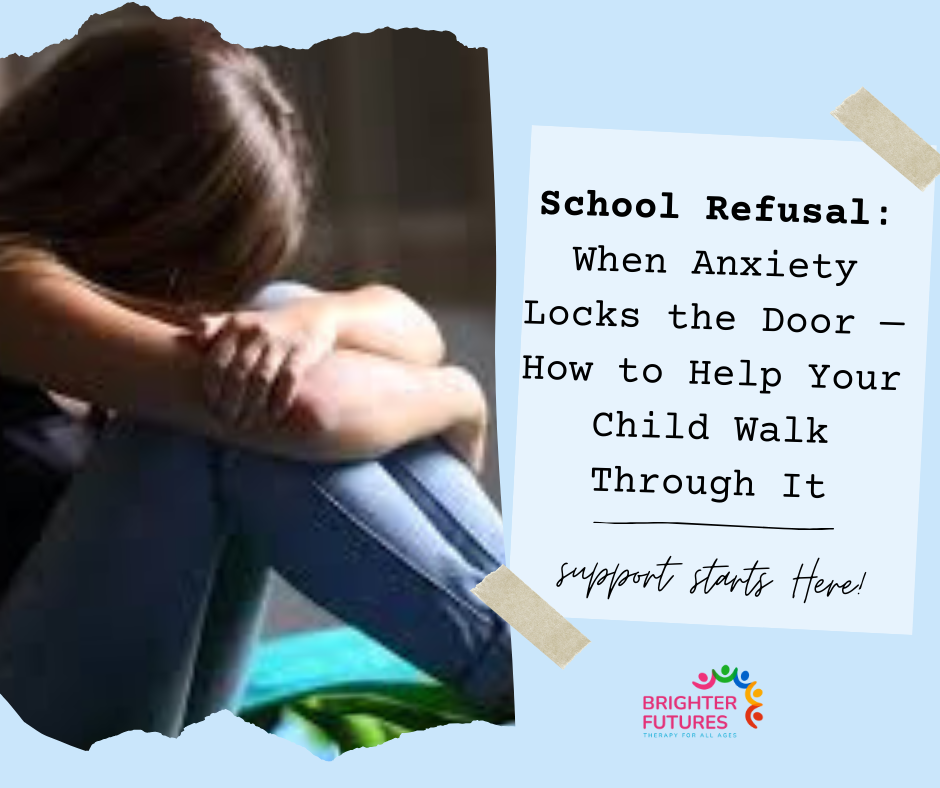School Refusal: When Anxiety Locks the Door—How to Help Your Child Walk Through It
Why Your Child Won’t Go to School and How You Can Help
🖊️ By Nicola McCay – NLP4Kids Licensed and Registered Practitioner
🚸 The Growing Concern of School Refusal
School refusal, often mistaken for truancy, is a growing issue across the UK and Ireland. Unlike truancy—where children deliberately avoid school without parental knowledge—school refusal is driven by intense emotional distress, making it extremely difficult for children to attend school, even when they want to.
📊 Did you know?
📍 Northern Ireland – The number of pupils missing 10% or more of school days doubled fromASBAEBSA 2017 to 2022 (Belfast Telegraph).
📍 Ireland – 60,000 children are absent from school daily, with anxiety being a key factor (Parentline.ie).
📍 UK – 1 in 3 children has missed school at least once in the past year—3.3 million students (The Times).
🛑 School refusal isn’t a choice—it’s a cry for help.
 EBSA
EBSA
💙 Parental Self-Care: Supporting Yourself to Support Your Child
👩👦 Parenting a child with school refusal can be overwhelming. It’s common to feel:
😞 Frustrated – “Why won’t they just go?”
😔 Guilty – “Am I handling this wrong?”
😟 Helpless – “Nothing I do is working.”
🔹 But here’s the truth: You need to care for yourself first to best support your child.
✅ Self-care strategies for parents:
🧠 Stay informed – Understanding anxiety helps you approach it with patience.
🎯 Set realistic goals – Progress is slow, but small wins matter.
💬 Seek support – Connect with other parents, professionals, or support groups.
🧘 Practice mindfulness – Deep breathing, journaling, and relaxation techniques help regulate your emotions before addressing your child’s anxiety.
🤔 Why Does School Refusal Happen?
🚨 Children experiencing school refusal may not even realise they have anxiety. Instead, it appears as:
🤢 Physical Symptoms – Stomach aches, headaches, nausea
😨 Panic Attacks – Tears, shaking, hyperventilating before school
😡 Behavioural Changes – Defiance, aggression, or emotional outbursts
🌙 Sleep Issues – Trouble falling or staying asleep
🚪 Avoidance – Refusing to get dressed or leave the house
🔍 Common Triggers:
💭 Anxiety & Stress – Social anxiety, fear of failure, or exam pressure.
👥 Bullying – Fear of social rejection or mistreatment.
👨👩👧 Separation Anxiety – Struggles with leaving parents.
📚 Learning Difficulties (SEN) – Feeling overwhelmed in class.
🏫 School Transitions – Moving to a new school or starting secondary education.
🎯 High Expectations – Perfectionism and academic pressure can lead to avoidance.
🚦 Recognising these signs early helps prevent long-term avoidance.
🛠️ How Parents Can Help
🙅♂️ Avoid saying: “You’re just being silly—school isn’t scary!”
💡 Instead, say: “I can see that school feels hard for you right now. Let’s work on this together.”
💡 The CALM Strategy: A Framework for Parents
Through my work with families experiencing school refusal, I developed the CALM Strategy to help parents reduce anxiety and rebuild trust.
🟦 C – Connect 🤝
Build a sense of safety and trust. Create an environment where your child feels comfortable expressing their fears.
🟦 A – Acknowledge 🗣️
Validate their emotions. Say, “I understand that school feels overwhelming right now.”
🟦 L – Listen 👂
Resist the urge to “fix” immediately—just listen. Ask open-ended questions like, “What part of school feels hardest for you?”
🟦 M – Model Self-Regulation 😌
Children learn by watching you! Demonstrate calm breathing, positive self-talk, and emotional resilience in stressful moments.
📌 Example: Using the CALM Strategy for Social Anxiety in School
👩🏫 Situation: Your child is afraid of answering questions in class.
✅ C – Reassure them that their feelings are normal.
✅ A – Acknowledge their fear: “Speaking in front of people can feel scary.”
✅ L – Ask them what would help: “Would sitting near a friend make it easier?”
✅ M – Show how you manage nerves (e.g., deep breaths before a speech).
🙌 Small changes lead to BIG results over time.
🚶♂️ Gradual Exposure: Small Steps to Reduce Avoidance
Avoiding school reinforces anxiety. Instead, break the process into smaller, manageable steps:
🟩 Step 1 – Walk near the school without going inside.
🟩 Step 2 – Visit the school when it’s quiet (after hours).
🟩 Step 3 – Attend short periods before building up to full days.
🟩 Step 4 – Create an exit plan so they feel in control (e.g., knowing they can take a break in a safe space).
🎯 Progress, not perfection!
📚 Collaborate with the School
Teachers and school staff want to help. Request:
📌 A Reduced Timetable – Shorter school hours at first.
📌 A Safe Space – A quiet area for breaks.
📌 Mentorship – A trusted teacher or buddy system.
👨🏫 Schools have resources—use them!
💡 When to Seek Professional Help
🚨 If school refusal persists despite efforts, professional support can be life-changing.
🔹 Therapies that help:
✔ NLP (Neuro-Linguistic Programming) – Reframes anxious thinking.
✔ CBT (Cognitive Behavioural Therapy) – Teaches coping strategies.
✔ EMDR (Eye Movement Desensitisation & Reprocessing) – Effective for trauma-related anxiety.
🙋♀️ I specialise in helping children overcome anxiety using these proven techniques.
🏁 Final Thoughts
💙 School refusal isn’t about defiance—it’s about fear.
✅ By validating emotions, identifying triggers, and using structured strategies like the CALM Strategy, you can help your child feel safe and supported in school again.
📧 Need more support? Contact me at: Nicola@NLP4Kids.org
Contact Number – UK 07879601659 or IRL 0873707433
🔗 Share This Post to Help Other Parents!
📢 Hashtags:
#BrighterFutures #TeenAnxietySupport #ParentingTeens #ChildAnxietyHelp #CBTforKids #NLP4Kids #KidsMentalHealth #TeenWellbeing #SchoolRefusal #SchoolAnxiety #ParentSupport #MentalHealthCoach #Strabane #Lifford #Donegal #Derry #UKParenting #IrelandParenting #GlobalAnxietySupport

Leave a Reply